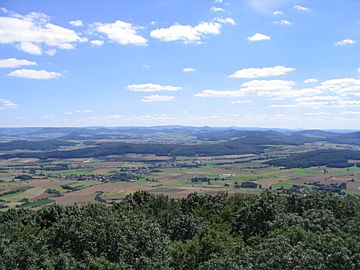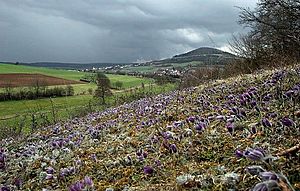Rhön Mountains facts for kids
Quick facts for kids Rhön Mountains |
|
|---|---|

View from the Soisberg looking south towards the Rhön
|
|
| Highest point | |
| Peak | Wasserkuppe |
| Elevation | 950 m above NN |
| Dimensions | |
| Length | 70 km (43 mi) |
| Area | 1,860 km2 (720 sq mi) |
| Geography | |
| Country | Germany |
| States/Provinces | Hesse, Bavaria and Thuringia |
| Range coordinates | 50°31′00″N 10°02′29″E / 50.516551°N 10.041391°E |
| Parent range | East Hessian Highlands |
| Geology | |
| Orogeny | Low mountains |
| Age of rock | 250 - 23 mya |
| Type of rock | Bunter sandstone, Muschelkalk, Keuper, Vulcanite |

The Rhön Mountains are a group of low mountains located in central Germany. They stretch across three German states: Hesse, Bavaria, and Thuringia. These mountains were formed by ancient volcanic activity. They are separated from the Vogelsberg Mountains by the Fulda River and its valley.
The Rhön Mountains are a very popular place for tourists. Many people come here to go hiking on the nearly 6,000 kilometers (3,750 miles) of trails. The scenery is beautiful and perfect for exploring. Gliding, which is flying without an engine, has been popular here since the early 1900s. Today, many families also enjoy staying on a farm for their holidays in the Rhön.
Since 1991, UNESCO has recognized the Rhön as a Biosphere Reserve. This means the area is special because it has unique plants and animals, and people are working to protect its natural beauty.
-
Wasserkuppe, highest point of Rhön and Hesse
Highest Mountains
The Rhön Mountains have several high peaks. Here are some of the tallest:
- Wasserkuppe is 950 meters (3,110 feet) tall. It is in the Hessian part of the Rhön.
- Kreuzberg (mountain) is 928 meters (3,040 feet) tall. It is in the Bavarian part of the Rhön.
- Schwabenhimmel is 926 meters (3,040 feet) tall. It is also in the Bavarian Rhön.
- Heidelstein is 913 meters (3,000 feet) tall. This peak is in the Bavarian Rhön too.
- Milseburg is 835 meters (2,740 feet) tall. It is located in the Hessian Rhön.
- Feuerberg is 832 meters (2,730 feet) tall. This mountain is in the Bavarian Rhön.
- Ellenbogen is 814 meters (2,670 feet) tall. It is found in the Thuringian part of the Rhön.
Nature in the Rhön
The Rhön Mountains are home to many different habitats and species of plants and animals. This is because of its unique geography and geology. Also, people have helped create valuable habitats over time by shaping the landscape.
Plant Life

The Rhön Mountains have a greater variety of plants than many other low mountain regions. Naturally, the area would mostly be covered by beech forests. However, today there are fewer beech trees. Some of the oldest beech woods are protected as part of the Rhön biosphere reserve.
Higher up, these beech woods are home to rare plants like the Alpine blue-sow-thistle and giant bellflower. In the lower beech woods, you can find a mix of mountain and other plants. Common wildflowers include the martagon lily, lily of the valley, and wild garlic. Many types of orchids also grow here, such as lady's slipper and lady orchid.
Only small parts of the Rhön are naturally open areas. These include raised bogs, rocky areas, and stone runs. These places have very special plants. The raised bogs, like the Red Moor and the Black Moor, are important for plants like sundews and cottongrass. On the volcanic rocks, you might find rare species like Cheddar pink and fir clubmoss.
There are no natural coniferous forests in the Rhön. But in mixed pine forests, you can find beautiful wildflowers like the lady's slipper orchid and burning-bush.
Over centuries, people have created a varied landscape with many different habitats. The large grassland areas are very important, but they are also sensitive. On the dry grasslands and juniper heaths, the silver thistle grows. This plant is a symbol of the Rhön region. You can also see gentians, pasque flowers, and many types of bee orchids.
The mountain meadows and mat grass fields on the higher slopes are very valuable habitats. Here, you can find plants like monkshood, martagon lily, and various orchids such as the greater butterfly orchid and perennial cornflower. In wet meadows and marshes, you might spot bog-bean and grass of Parnassus.
Wildlife
The animals in the Rhön Mountains are similar to those in other low mountain ranges. However, there are also some unique species. Common mammals include roe deer, foxes, badgers, hares, and wild boars. Smaller mammals like the dormouse and different types of water shrews also live here. A special regional species is the alpine shrew.
Many birds make their home in the Rhön. These include the black grouse, the capercaillie, the black stork, and the eagle owl. You might also hear the corncrake or see a red-backed shrike.
The Rhön is also home to two species that are found nowhere else in the world. These are a type of rove beetle and a local snail called the Rhönquellschnecke (Bythinella compressa).
Images for kids
-
Typical Rhön landscape near Tann, Hesse
-
Wasserkuppe, highest point of Rhön and Hesse
See also
 In Spanish: Rhön para niños
In Spanish: Rhön para niños
















